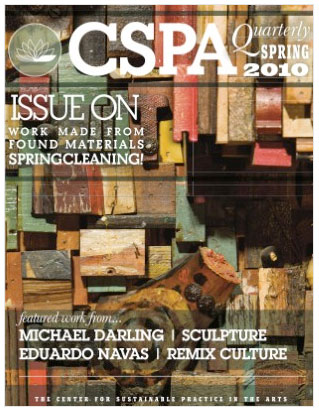“Remix: The Ethics of Modular Complexity in Sustainability” published in CSPA

My most recent text “Remix: The Ethics of Modular Complexity in Sustainability” is published in the CSPA Quarterly. The journal is the print publication for The Center for Sustainable Practice in the Arts, a non-profit that supports artists and organizations; it enables them to be ecologically and economically sustainable while maintaining artistic excellence. My text is not yet available online but I hope to have it released in a few months. I do share an excerpt at the end of this message. In the mean time, I encourage you to purchase a copy of the CSPA Quarterly, which focuses on works made with found materials.
Here is the issue release statement:
In this issue, we’re working against the stereotypes of the form, and attempting to broaden its term. As always, we’re exploring our chosen theme across disciplines and were delighted to include sculpture, visual art, theater, public art, and media art in the following pages. Instead of asking for work based on waste materials, we asked for work built from objects that already exist.
Excerpt from my text, “Remix: The Ethics of Modular Complexity in Sustainability”, page 13:
Remix and Sustainability
Within immaterial production (music and other arts dependent on forms of communication) recycling of existing material becomes an aesthetic with real repercussions. As stated in the introduction, Remix expands across culture from music to ecology: from immaterial pleasure to material responsibility. It is a binder that informs the awareness of the interrelation of one’s beliefs and actions in culture.
Once an idea or content becomes calculable, measurable as an actual thing produced, intellectual property becomes a pivotal issue: who owns the material and how should such material be re-used if it is to be recycled? Thus the result is that we live in a time where information is privileged and immaterial pleasure has become the prime commodity, as the global economy has assimilated a fourth layer of global production, which agriculture, industrial production, and the service industry support. Information plays a prime role in defining the other layers of production. As the emerging market it dictates how the others are represented. This shift places a certain stress on the sustainability of intellectual production, since ideas, its prime real estate, become more precious than ever before. Immaterial production is at the forefront of a global market that thrives on the low-cost of information production and outsourcing of repetitive labor in computing and networked services such as telemarketing, and social media to different areas around the world.
Complete text available on CSPA Quarterly








